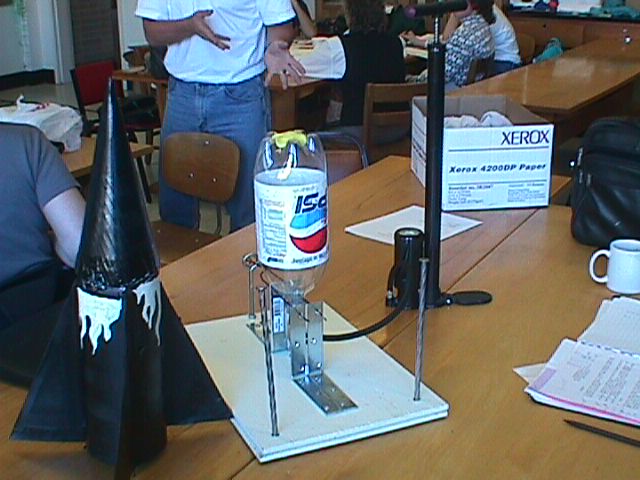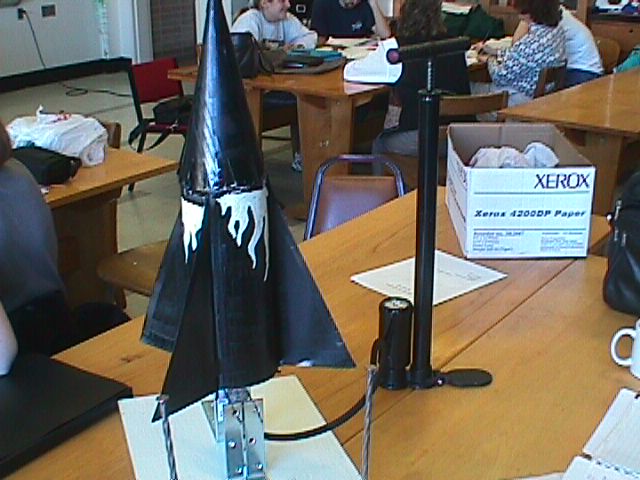|
(Before you begin, print out a worksheet
to use as you complete the activity.)
During the completion of this activity, you will demonstrate science
processing skills, an ability to use technological design, and an
ability to identify factors that affect motion and forces.
Bottle rockets are excellent devices for investigating
"Newton's Three Laws of Motion":
1st Law - A rocket will remain on the launch pad
until an unbalanced force is exerted, propelling the rocket upward.
2nd Law - The amount of force depends
upon how much air is pumped inside the rocket. You can increase
the force further by adding a small amount of water, which increases
the mass expelled by the air pressure in the rocket .
3rd Law - Finally, the action force
of the air (and water) as it rushes out of the nozzle creates an
equal and opposite reaction force propelling the rocket upward.
As with a balloon, air pressurizes the bottle rocket.
Adding a small amount of water to the bottle increases the action
force. The water expels from the bottle before the air does, turning
the bottle rocket into a bigger version of a water rocket toy (available
in toy stores).
Extension Activity: In order
to learn more about model rockets and how they work, follow these
links to information on Flight
of a Bottle Rocket,
Rocket Aerodynamics, and Forces
on a Rocket.
- You will work in teams to construct two water bottle rockets
with empty 2-liter soda bottles. You and your team members must
decide (1) on the design you will use as a result of experimenting
with
the simulators
and (2) on the materials you will use for
the body, fins, and cone of the rocket (which is placed over the
empty 2-liter soda bottle before launch). You will then predict
how well your rocket will fly and record your prediction on the
worksheet.
You may want to customize your rockets by decorating them in some
way. An example is shown below:

- One
bottle rocket launcher
is needed for the class. While one team launches
their rocket, another team can assist them by tracking the rocket,
determining how high it flew, and recording the information on
a worksheet.
(Follow this link to learn how to measure the altitude reached
by your rockets:
Model Rockets, Measured Altitude.) Then compare your prediction
with the rocket's actual performance and compare the flight of
your rocket with other rockets. Your final assignment will be
a journal entry via email giving details on your design, the comparisons
you made, and your conclusions on the reasons for the rockets'
performances.
-
You must follow the
safety rules
launching bottle rockets. Countdowns help everybody to know
when the rocket will lift off. Using the launch safety instructions
shown below, develop specific launch safety rules through group
discussions. In the rules, include how far back observers should
stand, how many people should prepare the rocket for launch,
and who should retrieve the rocket.

Rubrics:
Use the rubrics shown below as a guide when completing
the activity.
Rubric for constructing the
bottle rocket and recording observations
(30 points max.)
| |
Yes |
No |
| Team carries out assignment criteria |
3 points |
0 points |
| Team performs testing safely |
1 point |
0 points |
| Records observations and findings are correct |
3 points |
0 points |
| Team demonstrates proper science process skills |
3 points |
0 points |
| Participates in class discussions |
5 points |
0 points |
| Team kept on task |
5 points |
0 points |
| Bottle rockets fins aligned properly |
3 points |
0 points |
| Nose cone straight on rocket |
3 points |
0 points |
| Team contributes ideas to the class |
4 points |
0 points |
Rubric for email writing (Worksheet
Question 13)
(12 points max.)
| |
Yes |
No |
| Carries out assignment criteria |
3 points |
0 points |
| Records observations and findings are correct |
3 points |
0 points |
| Demonstrates proper science process skills |
3 points |
0 points |
| Spelling, grammar, and punctuation correct |
3 points |
0 points |
Alternative Recommended Assessments:
- Evaluate each bottle rocket on its quality of construction.
Observe how well the fins align and attach to the bottle. Also
observe the alignment of the nose cone at the top of the rocket.
- Evaluate the design and quality of construction of each bottle
rocket by measuring and comparing the altitudes that the rockets
reached.
Back to top
Close
Window
Any comments, concerns, or questions should be addressed
to: |
Developer: David
Mazza
Responsible NASA Official: Jo Ann Charleston
|
|
